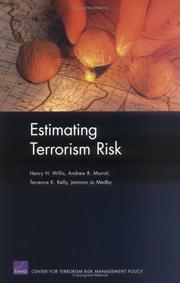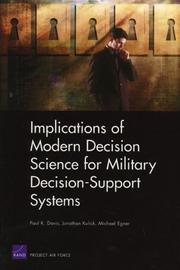| Listing 1 - 4 of 4 |
Sort by
|

ISBN: 0833040936 0833038346 9780833040930 9780833038340 9780833040886 083304088X Year: 2005 Publisher: Santa Monica, CA : RAND,
Abstract | Keywords | Export | Availability | Bookmark
 Loading...
Loading...Choose an application
- Reference Manager
- EndNote
- RefWorks (Direct export to RefWorks)
This monograph provides a practical definition of terrorism risk, presents a method of estimating it, and demonstrates a framework for evaluating this method. Results support conclusions on how to improve risk-based resource allocation.
Federal aid to terrorism prevention -- United States -- Planning. --- Terrorism -- Prevention. --- Terrorism -- United States -- Prevention. --- Terrorism risk assessment -- United States. --- Terrorism --- Federal aid to terrorism prevention --- Prevention. --- Risk assessment --- Planning. --- Acts of terrorism --- Attacks, Terrorist --- Global terrorism --- International terrorism --- Political terrorism --- Terror attacks --- Terrorist acts --- Terrorist attacks --- World terrorism --- Prevention --- Federal aid --- Direct action --- Insurgency --- Political crimes and offenses --- Subversive activities --- Political violence --- Terror --- Finance
Book

Year: 2023 Publisher: RAND Corporation
Abstract | Keywords | Export | Availability | Bookmark
 Loading...
Loading...Choose an application
- Reference Manager
- EndNote
- RefWorks (Direct export to RefWorks)
The Federal Emergency Management Agency's (FEMA's) Homeland Security Grant Program (HSGP) provides a suite of grants to help strengthen U.S. communities against terrorist attacks. To inform grant resource allocation decisions, FEMA has developed and maintains a risk-based formula to assess relative threat, vulnerability, and consequences of terrorist attacks in states and major urban areas. The formula helps FEMA decide how to use finite resources for the grant programs. As a result of the evolving threat landscape and as part of ongoing efforts to improve administration of the grant program, FEMA is performing a comprehensive review of the risk formula. As part of this review, the U.S. Department of Homeland Security (DHS) asked the Homeland Security Operational Analysis Center (HSOAC) to conduct an independent review of HSGP's risk formula and data sources. To assess the grant program's risk formula, the research team evaluated the data elements and sources in each component of the terrorism risk formula, reviewed the mathematical calculations used in the risk methodology, and considered alternative data elements and sources to account for the evolving threat environment. The evaluation framework used in this study addresses the formula's compliance with the program's authorizing language, legitimacy to stakeholders, and the validity and simplicity of the risk formula. The review suggests alternative approaches FEMA could consider to improve the risk formula and to address additional dimensions, such as community resilience and equity.
Terrorism --- Federal aid to terrorism prevention --- Terrorism --- Terrorisme --- Aide de l'État à la prévention du terrorisme --- Risk assessment --- Evaluation. --- Prevention. --- Évaluation du risque --- Évaluation. --- Homeland Security Grant Program (U.S.) --- Evaluation. --- United States

ISBN: 083304088X 0833038087 9780833040886 9780833038081 9780833041135 0833041134 0833038273 9780833038272 9780833041067 0833041061 Year: 2005 Publisher: Santa Monica, CA Rand, Project Air Force
Abstract | Keywords | Export | Availability | Bookmark
 Loading...
Loading...Choose an application
- Reference Manager
- EndNote
- RefWorks (Direct export to RefWorks)
A manual of standardized proficiency tests to help public health agencies develop strategies for testing their disease reporting systems.
Decision support systems. --- Military planning -- United States -- Decision making -- Data processing. --- United States. Air Force -- Research. --- Terrorism --- Terrorism risk assessment --- Federal aid to terrorism prevention --- Criminology, Penology & Juvenile Delinquency --- Social Welfare & Social Work --- Social Sciences --- Prevention --- Planning --- Military planning --- Decision making --- Data processing. --- United States. --- Research. --- War planning --- AF --- Air Force (U.S.) --- U.S.A.F. --- United States Air Force --- US Air Force --- USAF --- Management information systems --- Telematics --- Military administration --- Military policy --- AF (Air force) --- U.S.A.F. (Air force) --- USAF (Air force) --- Diseases --- Public health --- Reporting. --- Information services.

ISBN: 1282282824 9786612282829 0833041150 0833039407 9780833041159 9780833041098 0833041096 9780833039408 9780833041036 0833041037 0833038915 0833038931 9780833038913 9780833038937 0833038656 9780833038654 9781282282827 6612282827 9780833040985 0833040987 0833038478 9780833038470 9786612282867 1282282867 9780833040930 0833040936 9780833040886 083304088X 0833038346 9780833038340 9781433709524 143370952X Year: 2006 Publisher: Santa Monica, CA RAND Gulf States Policy Institute
Abstract | Keywords | Export | Availability | Bookmark
 Loading...
Loading...Choose an application
- Reference Manager
- EndNote
- RefWorks (Direct export to RefWorks)
In November 2005, New Orleans city leaders asked RAND to estimate the repopulation of the city in the aftermath of Hurricane Katrina. The Bring New Orleans Back Commission needed estimates of the city b2 ss population in the immediate future (the next three to six months) and the near-term future (the next one to three years) to guide the redevelopment planning process. The study was completed in early January 2006. A conceptual framework based on the costs and benefits of migration and on the role of social networks and physical constraints guided the estimates. Housing habitability was determined to be the key driver of the future population of New Orleans. RAND developed an approach to estimating future population for four points in time based on estimates of housing habitability, which were, in turn, determined by floodwater depth and the pace of housing reconstruction, as well as an estimate of the pre-Katrina population by the condition of its housing after Katrina. An important role for policymakers in shaping the repopulation process in New Orleans will be to minimize the uncertainty faced by residents and businesses by speeding up the reconstruction process.
Hurricane Katrina, 2005. --- City planning --- Cities and towns --- Civic planning --- Land use, Urban --- Model cities --- Redevelopment, Urban --- Slum clearance --- Town planning --- Urban design --- Urban development --- Urban planning --- Katrina, Hurricane, 2005 --- Planning --- Government policy --- Management --- New Orleans (La.) --- Big Easy (La.) --- Crescent City (La.) --- La Nouvelle-Orléans (La.) --- NOLA (La.) --- Nawlins (La.) --- Neu Orleans (La.) --- Nieuw Orleans (La.) --- Nouvelle-Orléans (La.) --- Neuva Orleans (La.) --- Nueva Orleans (La.) --- Nuova Orleans (La.) --- City of New Orleans (La.) --- Cité d'Orléans (La.) --- Population. --- Land use --- Art, Municipal --- Civic improvement --- Regional planning --- Urban policy --- Urban renewal --- Hurricanes --- Orleans Parish (La.) --- Terrorism -- United States -- Prevention. --- Terrorism -- United States. --- Health services administration --- Medical care --- Information technology. --- Delivery of health care --- Delivery of medical care --- Health care --- Health care delivery --- Health services --- Healthcare --- Medical and health care industry --- Medical services --- Personal health services --- Public health --- Health administration --- Health care administration --- Health care management --- Health sciences administration --- Health services management --- Health planning --- Public health administration --- Administration --- Terrorism --- Federal aid to terrorism prevention --- Prevention. --- Risk assessment --- Planning.
| Listing 1 - 4 of 4 |
Sort by
|

 Search
Search Feedback
Feedback About UniCat
About UniCat  Help
Help News
News